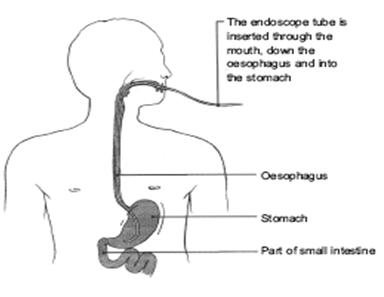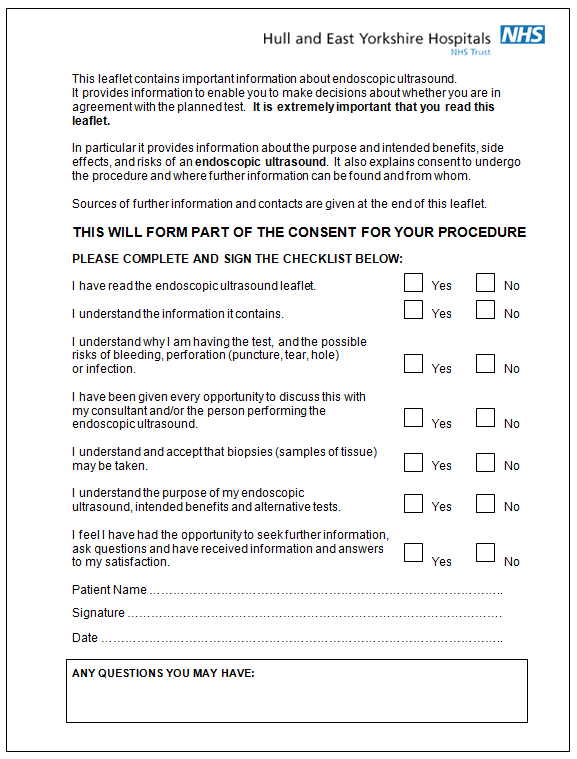- Reference Number: HEY-210/2022
- Departments: Endoscopy
- Last Updated: 10 November 2022
Introduction
This leaflet has been produced to give you general information about your procedure. Most of your questions should have been answered by this leaflet. It is not intended to replace the discussion between you and your doctor, but may act as a starting point for discussion. If after reading it you have any concerns or require further explanation, please discuss this with a member of the healthcare team.
Endoscopy Department contact numbers: Hull Royal Infirmary (01482) 674790 (direct line) and Castle Hill Hospital (01482) 622069 (direct line)
What is an Electronic Ultrasound?
You have probably been troubled by some symptoms, which have led to your doctor advising an endoscopic ultrasound. This is a test, which allows the endoscopists to look directly at the lining of the gullet (oesophagus), stomach, and first part of the small intestine (duodenum) – see diagram below. They can also look at images of the surrounding tissues and organs. A slim flexible tube with a light and an ultrasound on the end is gently passed from your mouth into your stomach. Pictures from the tube are shown on a TV monitor and an ultrasound monitor. A small sample of tissue (biopsy) can be taken for analysis in the laboratory. This is removed painlessly with a tiny pair of forceps.

The patient picture is reproduced with the permission of Health Press Limited from Neild P, Gazzard B. Patient Pictures – Gastroenterology, Oxford Health Press, 1997.
Why do I need an Electronic Ultrasound?
Your doctor will have asked for you to have an endoscopic ultrasound to enable him/her to make a decision about the next stage of your treatment.
Can there be any complications or risks?
All endoscopies carry a very small risk of haemorrhage (bleeding) or perforation (making a hole) of the bowel/stomach or gut. If this occurs, you will need to be admitted to hospital. Sometimes an operation is needed.
Other rare complications include a reaction to the sedation drugs. Some people, for reasons we still do not fully understand, are particularly sensitive to this drug. The breathing can be too shallow and too slow. In these cases we stop the examination, give more oxygen and if required we can give an antidote, which reverses the effect of the sedation. This is usually all that is needed and the person recovers with no ill or lasting effects.
In some cases, when people have another serious illness e.g., heart disease, stroke, unstable angina, severe asthma or chronic bronchitis, the sedation drug can cause difficulty in breathing. This is rare and is why we monitor breathing and heartbeat throughout; and why we give oxygen by nasal tubes.
In addition there is a possibility of developing aspiration pneumonia (fluid in the lungs). There is also a slight risk of damage to crowned teeth or dental bridgework. Common problems, which are not serious, include bruising from the sedation needle, a sore throat and bloating. If you would like to know more, please ask your nurse or endoscopist about the hospitals complication rate.
Are there alternatives to this test?
No. This test will provide more information about your problem and will complement other tests that you may have had already.
What if I refuse to have the Endoscopic Ultrasound?
This will not alter the manner in which we treat you and your standard of care will not change. However, it will be an important piece of information about your gastrointestinal tract that is currently unknown to us. Please discuss this with your doctor/specialist team.
Will I ever need an Endoscopic Ultrasound again?
This will depend on the reason for the test, what is found and whether it was possible to complete to test. Your nurse will keep you informed of any further appointments.
Who will do the test?
It may be a consultant or senior doctor who is trained and experienced in performing the test. Occasionally doctors who are undertaking endoscopic ultrasound training may perform your procedure. An experienced endoscopist will supervise them. Your permission will be requested in advance for this. You may decline and the supervising endoscopist will perform the endoscopic ultrasound.
Where will the test be performed?
Endoscopic ultrasound is mostly performed in the Endoscopy Department at Castle Hill Hospital. Specially trained doctors and nurses work here and are very experienced in performing endoscopic ultrasound and in the care it involves.
It will be done at Hull Royal Infirmary or Castle Hill Hospital depending on where your consultant is based. Please make sure you go to the correct Endoscopy Department. Directions will be given with your appointment letter. All the staff will help to make your stay as easy and dignified as possible. Please do not be afraid to ask questions.
How do I prepare for the test?
Please read the information leaflet. Share the information it contains with your partner and family (if you wish) so that they can be of help and support. There may be information they need to know, especially if they are taking care of you following this examination. Complete the health questionnaire sent/given to you as fully as possible.
To allow for a clear view, your stomach and first part of your intestine needs to be empty. You should not have any thing to eat and drink for at least 4 hours before your test. Do take any regular medicines up to this point.
If you have diabetes (especially taking insulin) or you have serious heart, lung or kidney problems, or concerned that a health problem you have may be affected, then contact the Endoscopy Department at the hospital you are having your examination (see contact numbers)
WARFARIN – These are blood thinning tablets and may have to be stopped for a period of time before your test, please contact your endoscopy department for advice.
PREGNANCY – It is important that you inform us if there is possibility that you may be pregnant. Any information you share with us will be kept strictly confidential.
LATEX – Please inform the department if you have a confirmed latex allergy as this will affect your appointment time.
CJD (commonly known as mad cow disease) – Please inform the department if you have been notified that you are at risk of CJD/vCJD (Creutzfeldt-Jakob disease/variant Creutzfeldt-Jakob disease) for public health reasons.
CLOPIDOGREL (PLAVIX) – This is a tablet that helps to reduce blood clots. You may need to temporarily stop this tablet before your test, please contact the Endoscopy Department for advice.
If you take any of the following blood thinning tablets please contact the Endoscopy Department before your appointment for further advice: APIXABAN, RIVAROXABAN, DABIGATRAN, ARGATROBAN, OR EDOXABAN
What happens to me in the Endoscopy Department?
Our friendly reception staff will greet you on arrival. They will let a nurse know that you have arrived. Occasionally there may be a delay in your appointment time due to an emergency taking place. If there are any delays you will be notified as soon as possible and be kept informed. A nurse will collect you from the waiting room and explain what will happen next. You will be given an approximate time of when you may be collected to go home. It is advisable to leave any valuables at home. We will ask you questions about your general health and work through the health questionnaire you have completed for us. Please feel free to ask questions.
The endoscopist will meet you and explain the test to you. You will both sign a consent form. This is to show you understand what will happen and agree to the procedure being performed. At any point during the procedure you can withdraw your consent and ask for the procedure to stop. If this happens the endoscopist or radiographer will stop the test. If you have any queries or worries, please tell us.
We will check your blood pressure, pulse, and oxygen levels, before your test. If you wear glasses or dentures, you will be asked to remove them. You will be taken to the examination room where you will be made comfortable on a bed on your left-hand side. If you are having sedation, the needle will be placed in the back of your hand
To keep your mouth open, a plastic mouth guard will be placed between your teeth. A fine plastic tube will rest by your nostrils to give you some extra oxygen. A probe will be placed on your finger to monitor your oxygen levels and pulse rate. If you are having sedation it will be given (at this time) and you will feel sleepy.
Do I need sedation?
Yes. People have sedation to keep them comfortable while the doctor carries out the test. Sedation is given through a needle in the back of your hand. It makes you feel sleepy and relaxed but does not put you to sleep. You can still respond to what is happening.
The doctor may also give you pain relief medication before the test begins. A throat spray containing a local anaesthetic is also often used.
Do I really need someone with me after sedation?
Yes. This is very important. The sedation given can have effects, which last some 24 hours after the test. You can become forgetful and also sleepy again. Your test may be cancelled if you do not arrange to have someone to collect you and stay with you for the next 24 hours.
We strongly recommend that for the next 24 hours you:
- Do not drive
- Do not return to work or operate machinery
- Do not sign any important/or legal documents
- Are not left alone, you may be at risk of injuring yourself
- Are not left alone to care for children
If you are an outpatient, the person accompanying you will be contacted to collect you. If you are an inpatient you will be transferred back to your ward.
What will the test feel like?
You may feel the tube gently slide over your tongue and down your gullet. It will not be painful, or interfere with your breathing. If you get a lot of saliva, the nurse will clear it with a sucker. You may feel the tube move around in your stomach. Some air will be passed down the tube to inflate your stomach to allow a clear view. The test normally takes 30 – 45 minutes.
How can I help myself?
You can help by listening to the instructions your nurse gives you. By staying calm and relaxed, the test goes quickly and easily. Try to control your breathing by taking slow deep breaths. This helps stop you wanting to retch.
What happens when the test is finished?
If you have had sedation, you will need to rest on a trolley in the recovery room for approximately 30 minutes. If you have had a biopsy, then you will be observed for between 2 and 4 hours. You will be helped to a chair and given a drink. It is quite likely that the back of your throat will feel sore for the rest of the day. You may feel bloated if some air remains in your stomach. Both discomforts usually pass without any medication.
When do I get the results?
The recovery nurse will check that you have a follow-up appointment with your own consultant before you leave the department. This will be written on your discharge form with any instructions that you need to follow.
Further information
If you require further information about your test your GP, consultant, and the Endoscopy Department is a valuable source of information.
Further information about your rights with regards to consent can be found in the following documents: These are free of charge.
- Department of Health (2001), Guide to Consent for Examination or Treatment.
- Department of Health (2001), Consent – What you have a right to expect.
- A Guide for Adults. (Available from the Endoscopy Department)
- A Guide for Relatives and Carers. (Available from the Endoscopy Department)
Visit the Department of Health’s website at: www.doh.gov.uk and for consent: www.doh.gov.uk/consent
Useful contact numbers:
The Endoscopy Department, Castle Hill Hospital(01482) 622069 (direct line) Monday – Friday: 8.00am – 5.00pm
The Endoscopy Department, Hull Royal Infirmary (01482) 674790 Monday – Friday: 8.00am – 5.00pm
Ward 100, Hull Royal Infirmary Out of hours (01482) 674860
What do the words in the leaflet mean?
- Biopsy: A sample of tissue is taken for analysis
- Consent: This is the agreement between you and the endoscopist. You are agreeing to have investigations or treatment and that you understand the purpose, benefits, alternatives and risks. You and the endoscopist during this process usually sign a consent form
- Duodenum: The part of the gut leading from the stomach
- Endoscopy Department: The place where endoscopy or examination takes place
- Endoscope: A tube for looking inside the body
- Endoscopist: This can either be your consultant, an experienced and trained doctor or an experienced and specially trained practitioner.
- Gastroscopy: Endoscopic inspection of the stomach (see endoscope)
- Oesophagus: The gullet. The pipe leading from the mouth to the stomach
This leaflet has been written with the help, support, advice and collaboration of:
- Consultants of the Department of Gastroenterology
- Consultants of the Surgical Department
- Staff of the Endoscopy Department
- Patients attending the Endoscopy Department

General Advice and Consent
Most of your questions should have been answered by this leaflet, but remember that this is only a starting point for discussion with the healthcare team.
Consent to treatment
Before any doctor, nurse or therapist examines or treats you, they must seek your consent or permission. In order to make a decision, you need to have information from health professionals about the treatment or investigation which is being offered to you. You should always ask them more questions if you do not understand or if you want more information.
The information you receive should be about your condition, the alternatives available to you, and whether it carries risks as well as the benefits. What is important is that your consent is genuine or valid. That means:
- you must be able to give your consent
- you must be given enough information to enable you to make a decision
- you must be acting under your own free will and not under the strong influence of another person
Information about you
We collect and use your information to provide you with care and treatment. As part of your care, information about you will be shared between members of a healthcare team, some of whom you may not meet. Your information may also be used to help train staff, to check the quality of our care, to manage and plan the health service, and to help with research. Wherever possible we use anonymous data.
We may pass on relevant information to other health organisations that provide you with care. All information is treated as strictly confidential and is not given to anyone who does not need it. If you have any concerns please ask your doctor, or the person caring for you.
Under the General Data Protection Regulation and the Data Protection Act 2018 we are responsible for maintaining the confidentiality of any information we hold about you. For further information visit the following page: Confidential Information about You.
If you or your carer needs information about your health and wellbeing and about your care and treatment in a different format, such as large print, braille or audio, due to disability, impairment or sensory loss, please advise a member of staff and this can be arranged.

